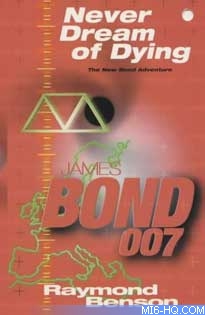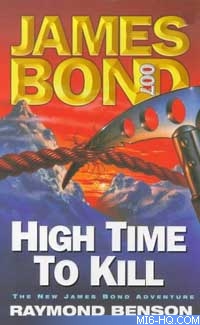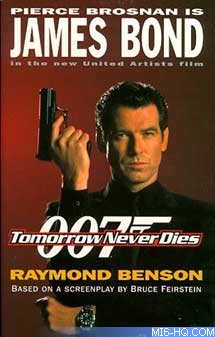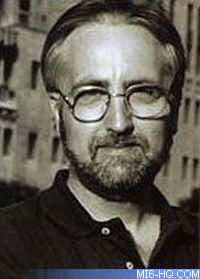 |
| |
MI6 caught up with the fourth official James Bond
author last month and chatted about his life before,
during and after his work with the world's most famous
literary spy...
|
|
Interview - Raymond Benson (Part 2)
May 20th 2004
MI6 caught up with the fourth official James Bond author last
month and chatted about his life, during and after his work with
the world's most famous literary spy. In this second part of the
interview, we talk about the years he spent writing 007…
|
The First Word..
How would you describe the balance of influences in
your novels between Fleming's original work and the movie
series? Are there any aspects which stay particularly close
to either camp?
Before I began the first novel, Peter and I discussed
how we would approach my series. We tossed around the idea
of freezing Bond in the Cold War era but ultimately rejected
that to stay in sync with the films. I was to make M a woman,
also to stay in sync with the films. Most importantly, I
was to attempt to blend aspects of the literary Bond with
the more well-known elements of the cinematic Bond. In other
words, I was to try and write Bond adventures that had feet
in both camps. That was not an easy task.
So, if my books read like film stories, there's a reason
for it! Besides, I tend to write cinematically anyway. I
had to put in more action and gadgetry but also keep the
human side of Bond intact.
I personally wanted to keep Bond a brooder, as he was in
the original Fleming's. I wanted him to have all his vices
intact (they had been missing for a while)-smoking, drinking,
womanizing, gambling… I wanted to bring back characters
from Fleming's Universe because that's what a continuation
writer does-just like someone writing Star Wars or Star
Trek books. I always loved it when Gardner brought back
an old character.
Basically I approached the books this way-I wrote what
I, as a fan, would have wanted to read in a Bond novel.
Luckily, Glidrose and the publishers backed me up.
|
|
"I
was to try and write Bond adventures that had feet in both
camps."

"Connery's most
human films are the first two."
|
Did the work on each of your novels follow (roughly) the
same pattern? Can you tell us a bit about the typical timeline
for one of your novels and the main phases before they go to print?
I had a strict schedule of delivery. Each book took approximately
eighteen months from conception to publication. When one was finished,
I immediately began the next one. The first phase was the outline
phase. I was required by contract to deliver an outline for approval
before receiving the green light to write the book. I usually
spent two to three months on the outline, conceiving the plot
and characters, working out what locations I would use, and researching
what technical things might figure into the story. Once the outline
was approved, I would go into the two to three month research
phase. This included my traveling to the various locations-observing
the people, eating the food, absorbing the atmosphere, staying
in the hotels-whatever was necessary. I would interview people
for information, such as the Royal Hong Kong Police task force
that was in charge of the Triads. Back home I would do other research
and prepare for the nitty-gritty writing, which was the third
phase. This usually took three to four months.
Once I had a first draft, I would go back over it and revise
and rewrite. I usually let two or three "readers" take
a look at the manuscript. These were people I trusted that were
heavy-duty, very literate Bond fans. (And my wife, who was my
harshest critic.) Finally, I would turn in the manuscript to Glidrose.
They would always have comments and suggestions, and I'd usually
go through another draft before they turned it over to the publishers.
Then my editors at Hodder and at Putnam would have comments and
suggestions. Most writers have only one editor. I had at least
three. The revision process usually took anywhere from one to
three months. Finally, when the manuscript was accepted for publication,
I would begin all over again with the next outline.
|

Above: Edition Never Dream of Dying
 UK
- MI6 Price: £5.59
UK
- MI6 Price: £5.59
 USA
- MI6 Price: $7.50
USA
- MI6 Price: $7.50
|
|
"...I wanted
to retain Bond's vices and flaws."
Titles in the Gardner era were generally decided by
committee of the publishers. Was this true for your novels?
Were there any that you particular like or despise?
That's absolutely right. The titles were the last things
to be created, and everyone had a hand in that. I usually
had a working title for the year I worked on the book. Then,
I suggested some further titles, Glidrose suggested some
titles, Hodder suggested some, and Putnam suggested some.
We'd haggle and discuss and argue and complain.
Each party had to be happy with the final title. Then,
if that wasn't enough, the marketing departments from both
publishers got involved. Sometimes they threw out what we
picked and we had to start all over! It was truly a nightmare.
Most of my suggested/preferred titles ended up as chapter
titles.
Only one of my titles made it to the final published book,
and that was Never Dream of Dying. That was my working title
and it stuck all the way through. For the most part, I was
able to live with the titles that were eventually used.
|
"I also had a bug
about bringing back the Walther PPK for Bond to use."
|
Both Fleming and Gardner enjoyed travel and it is evident
in their novels. Did you travel to all of your novel's locations?
Were there any significant locations that were a product
of your imagination, rather than real-life experience?
I tried to travel to every location, failing only in a
couple of instances. In those cases I had to do what most
writers do when they have to write about a place they've
never been-research and more research. Guide books, maps,
travel videos-these things help, but the best resource is
people. I'd find people that lived in those locations and
flood them with questions.
The most significant location that I had to write from
imagination was the Himalayan setting in High Time to Kill.
I tried to go to Nepal but a travel agent screw-up prevented
me from going. Instead, I spent time with the Gurkha regiment
in England and found out everything I could about the country.
In the end it didn't matter. I wasn't about to go mountain
climbing, even if I had made it to Nepal.
All that mountain climbing stuff-which turned out pretty
believable, if I do say so myself-came from diligent research.
|
|

Above: High Time to Kill
 UK
- MI6 Price: £4.79
UK
- MI6 Price: £4.79
|
Bond never ages but the world around him is ever-changing.
Which elements of Bond's world do you think were most important
to update, and which were kept as close as possible to Fleming's
era?
As I said before, I wanted to retain Bond's vices and flaws.
That's what makes him an interesting character. It might make
him anachronistic in this day and age but that's what defines
him as Bond. I also had a bug about bringing back the Walther
PPK for Bond to use. I just felt that this was Bond's gun. Sure,
it may be outdated and all, and I was certainly willing to let
him use more modern weaponry at times, but I liked him having
a fondness for his old, familiar handgun.
|

Above: Tomorrow Never Dies Novelisation
 UK
- MI6 Price: £4.79
UK
- MI6 Price: £4.79
|
|
"Of the three
novelizations, I definitely think Tomorrow Never Dies is
the best one..."
Did having the plot, characters and dialogue delivered
to you for the novelisation work take most of the fun out
of the writing? Were there strict guidelines you had to
adhere to, or could you stray off the path a little?
I wouldn't say it didn't take the fun out of writing them.
I had much less time to work on the novelizations-roughly
about six weeks to do one. The way it worked was that I'd
receive an early draft of the screenplay in the spring.
The book had to be turned in to Glidrose (and the publishers)
no later than the end of May or perhaps June in order for
the book to be published in November. So in all three cases,
the script was still evolving and being re-written as I
worked on the novelization. EON were usually still filming
and re-writing after I turned in the final manuscript.
I think I had the most freedom with Tomorrow Never Dies.
With that one, both Glidrose and EON didn't seem to care
if I changed some lines of dialogue here and there or embellished
some scenes. In all three cases I had to invent some scenes
to flesh out the books to acceptable lengths. If I had simply
put into prose what was in the screenplays, they would have
been too short! As the management of Glidrose (and the switch
to Ian Fleming Publications) changed, so did the people
in charge of licensing at EON.
|
I had less freedom with The World is Not Enough and especially
with Die Another Day. With the latter I wasn't allowed to change
a single line of dialogue, although I could still embellish and
invent some scenes. Of the three novelizations, I definitely think
Tomorrow Never Dies is the best one-it really works and stands
alone as something separate from the film. I look back on the
other two as being very workman-like.
I don't consider the novelizations to be a part of my original
novel series, but I'm pleased to have been given the opportunity
to do them. They made me feel as if I was putting in my two cents
worth to the film story. In all three cases, working with the
screenwriters (Bruce Feirstein, Robert Wade, and Neal Purvis)
was an enjoyable experience. They made themselves available to
answer questions and such.
"It's interesting,
because the film series has never liked to show Bond's human side."
|
The movie Bond is often seen as an invincible super-hero
(although that may have changed in the last couple of outings),
whereas Fleming's Bond showed the occasional human weakness
and imperfection.
For one example, in your novels you remind us that
Bond isn't the greatest at mathematics, yet in the film
"The World Is Not Enough" he calculates the ETA
of a pipeline bomb in a split second. In your opinion, has
the character of the two domains irreparably diverged?
"Irreparably" is a strong word. They've definitely
diverged but the character is still recognizable in both
camps.
It's interesting, because the film series has never liked
to show Bond's human side. It's crept out in a few cases,
most notably in OHMSS, and the two Dalton films.
I think Pierce Brosnan does a good job of showing some
real human emotion amidst a barrage of non-stop action.
|
|

Above: Raymond Benson
|
Connery's most "human" films are the first two. The
problem is that it seems that the filmmakers purposefully squelch
Bond's human characteristics. They want to make him superhuman,
the guy that can do anything at anytime. Life just isn't that
way. The books need to be a little more realistic and believable
because you're reading them over a longer time period and you
have the luxury to analyze and delve into whether or not the thing
is believable.
With a film, it's a two-hour amusement park ride and if the thrills
and excitement are there, that's all that matters. I do wish the
filmmakers would take their time in telling the story a bit more.
There are good screenplays for the later films-good plot lines
and situations-but the execution of them has become one of pacing
them so quickly that the audience never has time to get emotionally
involved.
Keep an eye out for the next part of the interview where
we chat about personal favorites the future.
Many thanks to Raymond Benson. Images
courtesy Amazon Associates
Related Articles
 MI6 Literary 007 Coverage
MI6 Literary 007 Coverage
 MI6
Interview - Raymond Benson (Part 1)
MI6
Interview - Raymond Benson (Part 1)
 MI6
Interview - Raymond Benson (Part 3)
MI6
Interview - Raymond Benson (Part 3)
 Raymond
Benson Official Website
Raymond
Benson Official Website